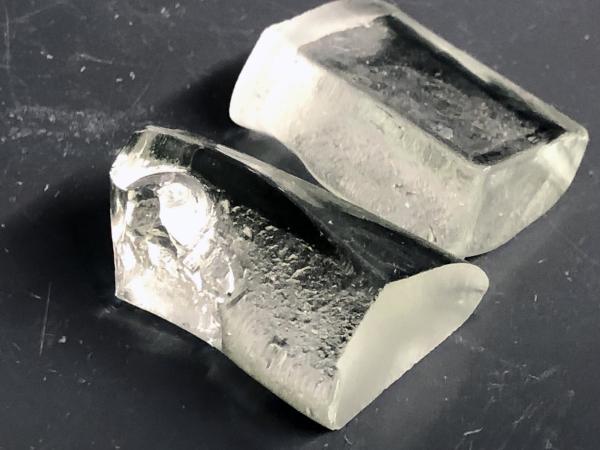
Date: 7 July 2023
The invention, called LionGlass and engineered by researchers at Penn State, requires significantly less energy to produce and is much more damage resistant than standard soda lime silicate glass. The research team recently filed a patent application as a first step toward bringing the product to market.
“Our goal is to make glass manufacturing sustainable for the long term,” said John Mauro, Dorothy Pate Enright Professor of Materials Science and Engineering at Penn State and lead researcher on the project. “LionGlass eliminates the use of carbon-containing batch materials and significantly lowers the melting temperature of glass.”
Soda lime silicate glass, the common glass used in everyday items from windows to glass tableware, is made by melting three primary materials: quartz sand, soda ash and limestone. Soda ash is sodium carbonate and limestone is calcium carbonate, both of which release carbon dioxide (CO2), a heat-trapping greenhouse gas, as they are melted.
“During the glass melting process, the carbonates decompose into oxides and produce carbon dioxide, which gets released into the atmosphere,” Mauro said.
But the bulk of the CO2 emissions come from the energy required to heat furnaces to the high temperatures needed for melting glass. With LionGlass, the melting temperatures are lowered by about 300 to 400 degrees Celsius, Mauro explained, which leads to a roughly 30% reduction in energy consumption compared to conventional soda lime glass.
Not only is LionGlass easier on the environment, it’s also much stronger than conventional glass. The researchers said they were surprised to find that the new glass, named after Penn State’s Nittany Lion mascot, possesses significantly higher crack resistance compared to conventional glass.
Some of the team’s glass compositions had such a strong crack resistance that the glass would not crack, even under a one kilogram-force load from a Vickers diamond indenter. LionGlass is at least 10 times as crack-resistant compared to standard soda lime glass, which forms cracks under a load of about 0.1 kilograms force. The researchers explained that the limits of LionGlass have not yet been found, because they reached the maximum load allowed by the indentation equipment.
“We kept increasing the weight on LionGlass until we reached the maximum load the equipment will allow,” said Nick Clark, a postdoctoral fellow in Mauro’s lab. “It simply wouldn’t crack.”
Mauro explained that crack resistance one of the most important qualities to test for in glass, because it is how the material eventually fails. Over time, glass develops microcracks along the surface, which become weak points. When a piece of glass breaks, it’s due to weaknesses caused by existing microcracks. Glass that is resistant to forming microcracks in the first place is especially valuable, he added.
“Damage resistance is a particularly important property for glass,” Mauro said. “Think about all the ways we rely on the strength of glass, in the automotive industry and electronics industry, architecture, and communication technology like fiber optic cables. Even in health care, vaccines are stored in strong, chemically resistant glass packaging.”
Mauro is hoping that the improved strength of LionGlass means the products created from it can be lighter weight. Since LionGlass is 10 times more damage resistant than current glass, it could be significantly thinner.
“We should be able to reduce the thickness and still get the same level of damage resistance,” Mauro said. “If we have a lighter-weight product, that is even better for the environment, because we use less raw materials and need less energy to produce it. Even downstream, for transportation, that reduces the energy required to transport the glass, so it's a winning situation for everyone.”
Mauro notes that the research team is still evaluating the potential of LionGlass. They have filed a patent application for the entire family of glass, which means there are many compositions within the LionGlass family, each with its own distinct properties and potential applications. They are now in the process of exposing various compositions of LionGlass to an array of chemical environments to study how it reacts. The results will help the team develop a better understanding of how LionGlass can be used throughout the world.
“Humans learned how to manufacture glass more than 5,000 years ago and since then it has been critical to bringing modern civilization to where it is today,” Mauro said. “Now, we are at a point in time when we need it to help shape the future, as we face global challenges such as environmental issues, renewable energy, energy efficiency, health care and urban development. Glass can play a vital role in solving these issues, and we are ready to contribute.”
Source: www.psu.edu | By Adrienne Berard
 600450
600450







Add new comment